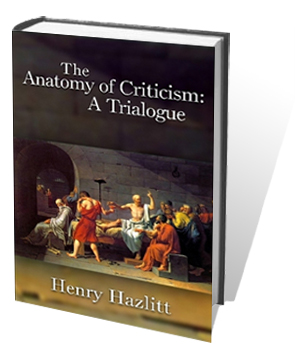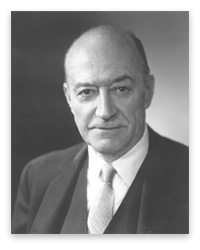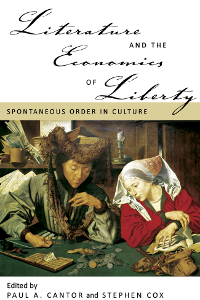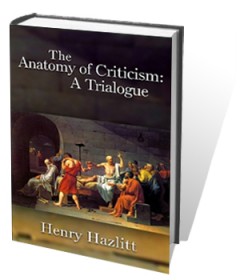 Remembered mostly for his contributions to economics, including his pithy and still-timely classic Economics in One Lesson (1946), Henry Hazlitt was a man who wore many hats. He was a public intellectual and the author or editor of some twenty-eight books, one of which was a novel, The Great Idea (1961) — published in Britain and later republished in the United States as Time Will Run Back (1966) — and another of which, The Anatomy of Criticism (1933), was a trialogue on literary criticism. (Hazlitt’s book came out twenty-four years before Northrop Frye published a book of criticism under the same title.) Great-great nephew to British essayist William Hazlitt, the boy Henry wanted to become like the eminent pragmatist and philosopher-psychologist William James, who was known for his charming turns of phrase and literary sparkle. Relative poverty would prevent Hazlitt’s becoming the next James. But the man Hazlitt forged his own path, one that established his reputation as an influential man of letters.
Remembered mostly for his contributions to economics, including his pithy and still-timely classic Economics in One Lesson (1946), Henry Hazlitt was a man who wore many hats. He was a public intellectual and the author or editor of some twenty-eight books, one of which was a novel, The Great Idea (1961) — published in Britain and later republished in the United States as Time Will Run Back (1966) — and another of which, The Anatomy of Criticism (1933), was a trialogue on literary criticism. (Hazlitt’s book came out twenty-four years before Northrop Frye published a book of criticism under the same title.) Great-great nephew to British essayist William Hazlitt, the boy Henry wanted to become like the eminent pragmatist and philosopher-psychologist William James, who was known for his charming turns of phrase and literary sparkle. Relative poverty would prevent Hazlitt’s becoming the next James. But the man Hazlitt forged his own path, one that established his reputation as an influential man of letters.
In part because of his longstanding support for free market economics, scholars of literature have overlooked Hazlitt’s literary criticism; and Austrian economists — perhaps for lack of interest, perhaps for other reasons — have done little to restore Hazlitt’s place among the pantheon of twentieth-century literary critics. Yet Hazlitt deserves that honor. He may not have been a Viktor Shklovsky, Roman Jakobson, Cleanth Brooks, William K. Wimsatt, John Crowe Ransom, Allen Tate, Lionel Trilling, Dwight Macdonald, or Kenneth Burke, but Hazlitt’s criticism is valuable in negative terms: he offers a corrective to much that is wrong with literary criticism, both then and now. His positive contributions to literary criticism seem slight when compared to those of the figures named in the previous sentence. But Hazlitt is striking in his ability to anticipate problems with contemporary criticism, especially the tendency to judge authors by their identity. Hazlitt’s contributions to literary criticism were not many, but they were entertaining and erudite, rivaling as they did the literary fashions of the day and packing as much material into a few works as other critics packed into their entire oeuvres.
Hazlitt became literary editor of The Nation — a position once held by Paul Elmer More — in 1930. At that time, formalism was the dominant school of literary analysis in Russia, and the New Criticism was in its nascent stages in America. The former scrutinized supposedly invariant linguistic patterns or grammars of poetry and sought to divorce authorial biography from textual criticism. Formalism also sought to break down literature into its constituent elements: form, irony, meter, voice, plot, point of view, and so forth. Proponents of Russian formalism included Shklovsky, Boris Eikhenbaum, Yuri Tynyanov, Boris Tomashevsky, Vladimir Propp, and Roman Jakobson. Each of these men produced idiosyncratic works that have in common a certain attention to the manifest structure of language. Each considered syntactical systems as imperative to the organization and meaning of artistic works. In 1930, the same year in which Hazlitt assumed his position at The Nation, Shklovsky renounced formalism, which had come under assault by socialist and communist ideologues who insisted that criticism tow party lines and tolerate no dissent. It would be another three decades at least before Russian formalism received extensive critical treatment in America — except among small Slavicist academic circles — but the commonalities shared by formalism and the New Criticism reveal something (what, exactly, is debatable) about the global trajectory of literary criticism during a topsy-turvy era.
Spearheaded mostly by conservative Southern gentlemen who maintained traditional literary and aesthetic values and who recognized the self-referential unity of texts, the New Criticism sought to preserve the integrity of writing by isolating works of literature from sociological and historical externalities. The New Criticism championed close reading and rigorous explication and identified the importance of textual structure to meaning. For this reason, the New Criticism was principally pedagogical. It achieved its fullest realization in the works of Ransom, Cleanth Brooks, I. A. Richards, Allen Tate, William K. Wimsatt, and Monroe Beardsley (the latter two together coined the term “intentional fallacy” to refer to interpretive assumptions about authorial intent). During Hazlitt’s tenure at The Nation, only Richards and William Empson had published works that would later fall within the ambit of the New Criticism, which drew its name from the title of Ransom’s 1941 work bearing those words as its title. Only the New Humanists — most notably, Irving Babbitt and Paul Elmer More — had gained similar widespread recognition as public intellectuals and distinguished litterateurs in the classical tradition, although a number of rhetoricians, philosophers, linguists, and thinkers — Kenneth Burke in America, Martin Heidegger in Germany, Wittgenstein in Austria and England, Sartre in France — had gathered notable followers for their less traditional methods and practices.
Hazlitt published The Anatomy of Criticism in 1933, not long before he would succeed H.L. Mencken as editor of The American Mercury. The book does not fit neatly within established critical paradigms. Its ability to circumvent totalizing labels and to defy reductive classification is arguably its most stunning achievement. That same year, Babbit died, having recently seen the publication of On Being Creative (1932), a collection of penetrating essays on culture and education. Also that year, George Santayana, now living in Europe, came out with Some Turns of Thought in Modern Philosophy; T.S. Eliot held the Charles Eliot Norton professorship at Harvard University; Robert Frost published The Lone Striker; the once notorious Bloomsbury Group began to lose its luster and novelty; Gertrude Stein released The Autobiography of Alice B. Toklas; James Joyce’s Ulysses found print in the United States; the Harlem Renaissance reached its zenith; and notable poets — William Butler Yeats, Marianne Moore, Wallace Stevens, William Carlos Williams, e.e. cummings, Ezra Pound — blessed us with memorable and powerful verse. In short, Hazlitt’s book of criticism appeared during a flowering age for literature (although not for politics!) across the English-speaking world. These various works and movements reflect differing attitudes and literary standards from place to place, but their simultaneous production and proliferation bespeak of the prominence that literature, then a cultural touchstone, once enjoyed.

The Anatomy of Criticism unfortunately lacks the Austrian perspective that eventually set Hazlitt apart from fashionable thinkers and commentators on economics. Its themes, arguably old-fashioned, recall such eighteenth-century writings as David Hume’s “Of the Standard of Taste.” Hazlitt questions, for instance, whether there are universal criteria for taste. He uses the term “criticism” to signify the evaluation of works of literature according to definite standards. If this approach seems dated, perhaps snobbish, it is because few critics besides Harold Bloom — who made a name for himself by evaluating works based on style, suggestive value, distinctiveness, permanence, and artistry — still deal in these debates.
The Anatomy of Criticism opens with an apology. “Somehow I feel that I ought to apologize for having cast the present volume in dialogue,” Hazlitt submits, adding, “I do not know precisely why one should feel obliged to offer excuses for employing a form that goes back at least to Plato, that has been used by Hobbes, Hume, Berkeley, Voltaire, Diderot, Schopenhauer, De Quincey, Landor, and, in our own day, by Lowes Dickinson and Santayana.” This apology seems like an appropriate opening, not because an apology was in order but because the apology as a medium calls attention to the dualities at work in a writer’s mind. By employing dialogue, Hazlitt shows that he isn’t cocksure or unreflective about his positions, which he apparently arrives at only after challenging himself (or his alter egos). That spirit of inquiry informs Hazlitt’s methodology throughout; for he claims not to attempt to prove that one side or another is true, but “by trying to get at the difficulty and determining in what respect and to what extent each side is justified.” This measured approach stood in contradistinction to the emerging Marxist criticism that took as its starting point particular essentialized assumptions about the nature of man and class relations, and that presupposed answers to questions without so much as testing or validating the logical — or practical — links between those answers and questions.
Hazlitt divided The Anatomy of Criticism into ten dialogues and appended the book with two short essays: “Literature and the Class War” and “Marxism or Tolstoyism?” Hazlitt’s most prescient piece in this volume — and the only one written in the first person — is “Literature and the ‘Class War,'” which picks away at various Marxist routines of literary criticism. Some sixty years before contemporary literary Marxists like Terry Eagleton or Fredric Jameson underwent pointed reproach for their reductionist and determinist class/culture critiques, Hazlitt wrote, quite prophetically,
One feels that few of the writers whose [Marxist] theories are being examined will trouble to weigh on their merits any of the specific objections offered. For most of the nouveau-Marxists know all the answers in advance. They know that any critic who questions any item in the Marxian ideology is a ‘bourgeois’ critic, and that his objections are ‘bourgeois’ criticisms, and from that terrible and crushing adjective there is no appeal. For the bourgeois critic, if I understand the nouveau-Marxists rightly, has less free will than a parrot. He is mere phonography, who can only repeat the phrases and opinions with which he has been stuffed from his reading of bourgeois literature and his contacts with bourgeois science and bourgeois art. All these make up bourgeois culture, which is a mere class culture, i.e., an elaborate and colossal system of apologetics; worse, an instrument for class dominance and class oppression.
The irony, or paradox, was that the Marxist critics who recycled and re-inscribed tired attacks on bourgeois culture were many of them from the privileged classes. Hazlitt points to the fact that Marx and Lenin were highly literate, even immersed in the artistic and aesthetic tastes of the bourgeois culture, to suggest that “a work literature is not necessarily to be dismissed as inferior because it grows out of a society in which social injustice prevails, even if it is the product of an oppressing class or of a slave-holding class.” Qualifying this statement, Hazlitt adds, “To call a work of literature ‘bourgeois’ … would not have meant for Marx that it was necessarily not a great work. And as a corollary, to call a work of art ‘proletarian’ would not have meant for him that it was necessarily admirable.” If I am reading this right, Hazlitt’s point is that the shared knowledge and vocabularies of communities — what Michel Foucault would later call “discourse” — do not determine the thoughts of authors or the nature of aesthetic output. Marx’s ideas were no more a product of class than were, and are, the great literature of the great authors.
Hazlitt seems to suggest that writers are influenced though not determined by culture:
Shakespeare, as a seventeenth-century writer, was naturally limited by the lack of knowledge and many of the prejudices of his age; his age colors his work. Does that mean that he is of little value to the twentieth-century reader? Because Dreiser is a man, does he lose his value for women readers? Does Willa Cather lose hers for men readers? The answers to these questions are so obvious that it seems almost childish to ask them. The great writer with great imaginative gifts may universalize himself. If not in a literal sense, then certainly in a functional sense, he can transcend the barriers of nationality, age, and sex. And certainly he can, in the same functional sense and to the same degree, transcend the barrier of class.
What Hazlitt takes to task here is the Marxist denial of human agency, the totalizing view of humans as trapped within determinant positions in uninterrupted modes of production. For Hazlitt, writers and artists are more than merely inscribed in the materialist conception of history or trapped at the nexus of base and superstructure. Writers do far more than transform the mode of production into an aestheticized object validating the status quo. Great writers and artists can and do transcend their historical moment — is it too much to say, à la Russell Kirk, that they tap into the permanent things? — even if, like Shakespeare or Dreiser or Cather or anyone, they are limited by a lack of knowledge and by the prejudices of their age. By way of analogy, the American founders could not help but hold views that transgress contemporary sensitivities and standards — just as we cannot help but hold views that later generations will find offensive or silly — yet the American founders did not simply reproduce and recite the discourses in which they were immersed. On this score, Hazlitt appears to have anticipated Paul Cantor’s celebration of Austrian economists, who, Cantor says, “do not accept the idea of a master science, one method of knowing that provides the key to understanding all phenomena.”
The personae of The Anatomy of Criticism are Elder, an essayist and professor of English literature; Arthur, a popular novelist; Middleton, a highbrow pedant and editor of a monthly philosophical and literary journal; and Young, a youthful book reviewer. These aptronymic figures converse in playful, Victorian language of the Oxbridge dinner party variety. Naysayers might accuse Hazlitt, in light of his elevated diction and lively, ostentatious syntax, of elitism or anachronism; they might also find his dialogue format equivocal and unserious. But that is a matter of taste. And as Hazlitt’s character Elder submits, “Taste is not an infallible guide even in the domain of food; as in literature, it must be supplemented by knowledge.” In any case, no one can accuse Hazlitt of wanting in literary knowledge, for his characters refer to countless critics and their theories and also reference several of what have been called “the Great Books,” as well as a few of the not-so-great ones (the novels of E. Phillips Oppenheim or Temple Bailey come to mind).
In the chapter called “Criticism’s Right to Exist,” Elder has arranged for Arthur and Young to debate the baffling subject of criticism. Arthur proposes discontinuing criticism altogether, whereas Young, not to be outdone, thinks it is the critic’s duty “to render an honest report to the reading public.” The title of the chapter betrays Hazlitt’s stance on the matter. (He believes in the qualified value of criticism.) Other chapters undertake equally pressing literary matters — the meaning of an aesthetic register, the function of the critic, the effects of culture upon authors, the periodization of the canon, the politics of interpretation, the authority of our impressions, market demand as an indicator of quality, and on and on — but the explication of these chapters would require far more space than is permissible in a short article. Elsewhere, I intend to say more. For the purposes of this profiling piece, though, it will suffice to say that Hazlitt’s criticism is no less incisive for being witty and conversational. To read Hazlitt’s criticism is to come under the allure of a man who conveys complicated ideas through the clear if pompous speech of likeable, fictional authorities. Middleton, for instance, offers this insight that goes some length toward resolving the aforementioned dispute about Marxist determinism and free will of the author: “[Literature] is an expression of the age, surely: a great work of literature both helps to make the age, by being an influence in it and a part of it, and is made by the age, because itself influenced by the works that preceded it.” (On this subject, Middleton later remarks that “I should not go so far as to assert, with some of the followers of Karl Marx, that it is the economic conditions under which the great masses of men live and work that fundamentally determine what the age shall think — in other words, that this time-spirit is a mere passive ideological mirror of those conditions.”)
 Austrian economics and literature have become paired terms lately, due in large part to the tenacious efforts of Paul Cantor and Stephen Cox, but also to enthusiasts and scholars like Troy Camplin, whose blog Austrian Economics and Literature has earned a large and loyal following. Because of this emerging trend in literary-cum-economic theory, the legacy and criticism of Hazlitt will only grow in importance. The most important literary developments over the last century have, I would argue, taken place outside the academy; and the escalating attention to Austrian economics and literature, and accordingly to Hazlitt, would seem to indicate a fundamental change in literary study from the outside, a change that frees criticism and theory from monopolistic and propagandistic restraints imposed by too many humanities professors. Studying Hazlitt will only energize and authorize this movement that counteracts the degeneration of English departments into a comfortable podium for experts in literature to cherry-pick from economic ideas that other disciplines have mostly discredited. If only Hazlitt had integrated his economic and literary theory, we might have had more to say about him. He didn’t make many novel contributions to the interpretation of literature, but those of us who admire him might join his Austrian economics with his literary criticism to reconsider various texts and undo the effects of bad literary-economic theory.
Austrian economics and literature have become paired terms lately, due in large part to the tenacious efforts of Paul Cantor and Stephen Cox, but also to enthusiasts and scholars like Troy Camplin, whose blog Austrian Economics and Literature has earned a large and loyal following. Because of this emerging trend in literary-cum-economic theory, the legacy and criticism of Hazlitt will only grow in importance. The most important literary developments over the last century have, I would argue, taken place outside the academy; and the escalating attention to Austrian economics and literature, and accordingly to Hazlitt, would seem to indicate a fundamental change in literary study from the outside, a change that frees criticism and theory from monopolistic and propagandistic restraints imposed by too many humanities professors. Studying Hazlitt will only energize and authorize this movement that counteracts the degeneration of English departments into a comfortable podium for experts in literature to cherry-pick from economic ideas that other disciplines have mostly discredited. If only Hazlitt had integrated his economic and literary theory, we might have had more to say about him. He didn’t make many novel contributions to the interpretation of literature, but those of us who admire him might join his Austrian economics with his literary criticism to reconsider various texts and undo the effects of bad literary-economic theory.
Nothing is exempt from the principles and teachings of economics; everything, for instance, is subject to supply and demand. Likewise, nothing is outside the reach of literature or the imagination. It would seem that the economic and literary enterprises are mutually illuminating and interactive — that the one enterprise is done better when considered alongside the other. Since my recent interview with Jeffrey Tucker about the state of literary study and the humanities, I have received several emails from both undergraduate and graduate students wanting to know more about Austrian economics and literature, and wanting to get involved in the AE&L movement, if such an acronym may be employed. These are exciting times for those who love literature and liberty, and who think that literature generates more liberty, just as liberty generates more literature.















